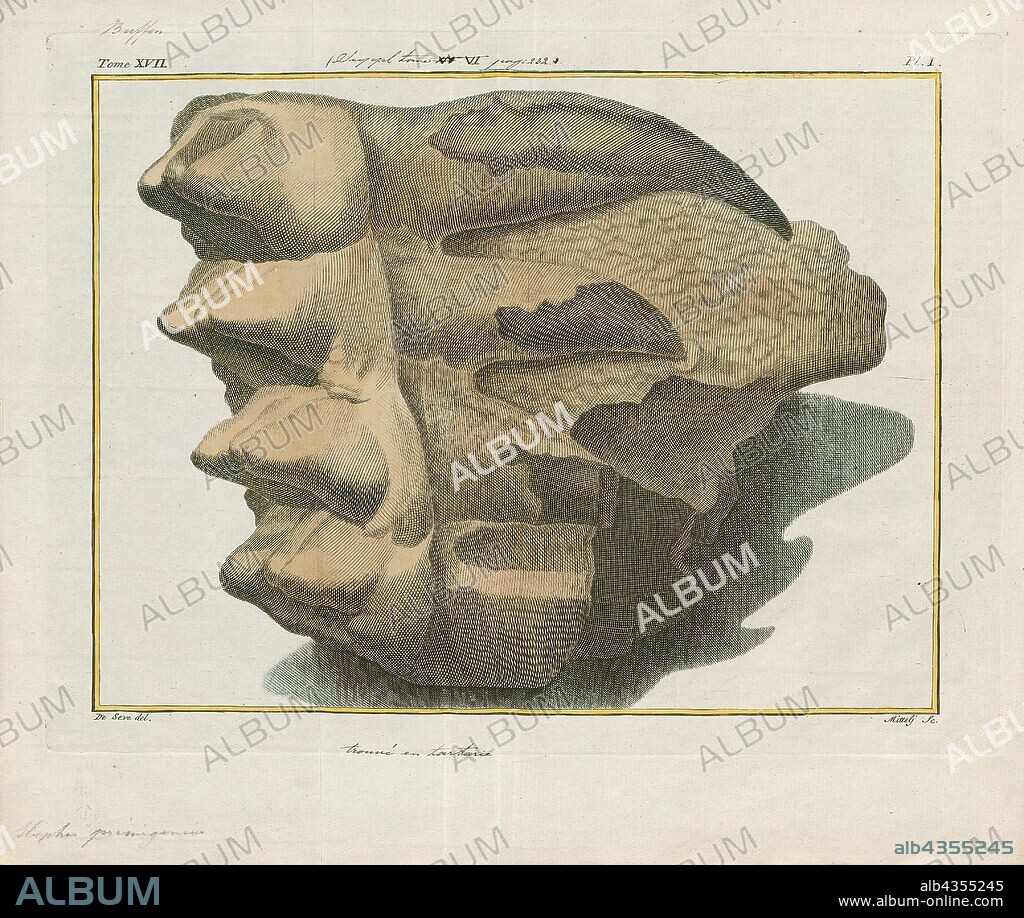alb4355245
Elephas primigenius, Print, The woolly mammoth (Mammuthus primigenius) is an extinct species of mammoth that lived during the Pleistocene until its extinction in the early Holocene epoch. It was one of the last in a line of mammoth species, beginning with Mammuthus subplanifrons in the early Pliocene. The woolly mammoth diverged from the steppe mammoth about 400, 000 years ago in East Asia. Its closest extant relative is the Asian elephant. The appearance and behaviour of this species are among the best studied of any prehistoric animal because of the discovery of frozen carcasses in Siberia and Alaska, as well as skeletons, teeth, stomach contents, dung, and depiction from life in prehistoric cave paintings. Mammoth remains had long been known in Asia before they became known to Europeans in the 17th century. The origin of these remains was long a matter of debate, and often explained as being remains of legendary creatures. The mammoth was identified as an extinct species of elephant by Georges Cuvier in 1796., molars.

|
Add to another lightbox |
|
Add to another lightbox |



Caption:
Elephas primigenius, Print, The woolly mammoth (Mammuthus primigenius) is an extinct species of mammoth that lived during the Pleistocene until its extinction in the early Holocene epoch. It was one of the last in a line of mammoth species, beginning with Mammuthus subplanifrons in the early Pliocene. The woolly mammoth diverged from the steppe mammoth about 400, 000 years ago in East Asia. Its closest extant relative is the Asian elephant. The appearance and behaviour of this species are among the best studied of any prehistoric animal because of the discovery of frozen carcasses in Siberia and Alaska, as well as skeletons, teeth, stomach contents, dung, and depiction from life in prehistoric cave paintings. Mammoth remains had long been known in Asia before they became known to Europeans in the 17th century. The origin of these remains was long a matter of debate, and often explained as being remains of legendary creatures. The mammoth was identified as an extinct species of elephant by Georges Cuvier in 1796., molars
Credit:
Album / quintlox
Releases:
Model: No - Property: No
Rights questions?
Rights questions?
Image size:
4346 x 3670 px | 45.6 MB
Print size:
36.8 x 31.1 cm | 14.5 x 12.2 in (300 dpi)
Keywords:
000 YEARS AGO • 1796 • 17TH CENTURY • 400 • ALASKA • ANIMAL: MAMMOTH • ANY PREHISTORIC ANIMAL • APPEARANCE • ASIA • ASIAN ELEPHANT • BEHAVIOUR • BEST STUDIED • CLOSEST EXTANT RELATIVE • COG • DEBATE • DENTITION • DENTURE • DEPICTION • DISCOVERY • DUNG • EARLY HOLOCENE EPOCH • EARLY PLIOCENE • EAST ASIA • ELEFANT • ELEPHANT • ELEPHAS PRIMIGENIUS • EUROPEA • EUROPEAN • EXPLAINED • EXTINCT SPECIES • EXTINCTION • FROZEN CARCASSES • GEORGES CUVIER • IDENTIFIED • LAST • LEGENDARY CREATURES • LIFE • LINE • LIVED • LONG • MAMMOTH REMAINS • MAMMOTH SPECIES • MAMMOTH • MAMMOTH, ANIMAL • MAMMUTHUS PRIMIGENIUS • MAMMUTHUS SUBPLANIFRONS • MANURE • MATTER • MOLARS • ORIGIN • PLEISTOCENE PERIOD • PLÉISTOCÈNE • PREHISTORIC CAVE PAINTINGS • PRINT • PRONG • REMAINS • SET OF TEETH • SIBERIA • SKELETONS • SPECIES • STEPPE MAMMOTH • STOMACH CONTENTS • TEETH • TOOTH • WELL • WOOLLY MAMMOTH DIVERGED • WOOLLY MAMMOTH
 Pinterest
Pinterest Twitter
Twitter Facebook
Facebook Copy link
Copy link Email
Email
